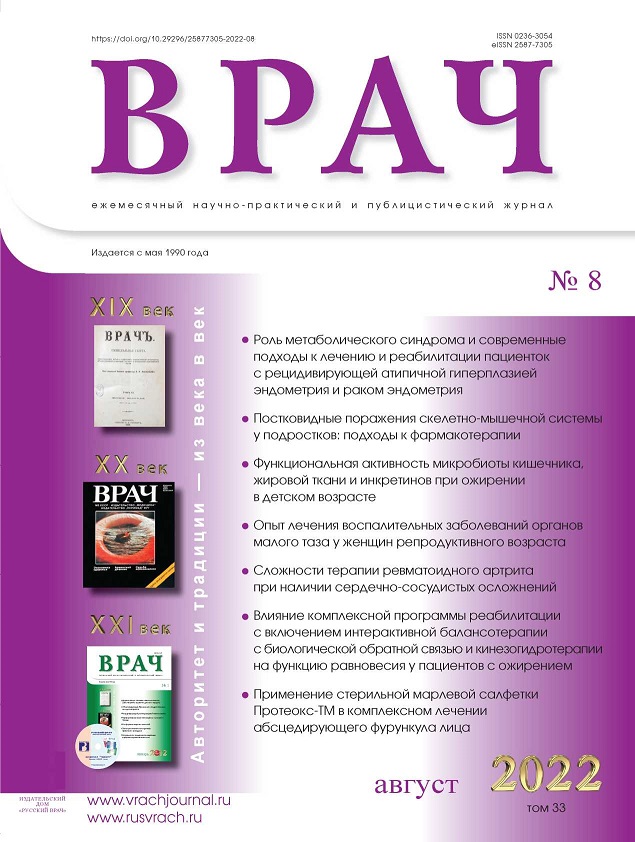Аденомиоз: современные диагностические возможности
- Авторы: Клинышкова Т.В.1, Чернышова Н.П.2, Совейко Е.Е.3
-
Учреждения:
- Омский государственный медицинский университет Минздрава России
- Клиническая больница «РЖД-Медицина»
- ООО Клинико-диагностический центр «Ультрамед»
- Выпуск: Том 33, № 8 (2022)
- Страницы: 28-32
- Раздел: Для диагноза
- URL: https://journals.eco-vector.com/0236-3054/article/view/114665
- DOI: https://doi.org/10.29296/25877305-2022-08-05
- ID: 114665
Цитировать
Полный текст
Аннотация
Цель. Оценить результаты комплексного обследования пациенток с аденомиозом. Материал и методы. В исследовании приняли участие 59 пациенток репродуктивного возраста и в пременопаузе (40,5±6,2 года) с аденомиозом, верифицированным в 42 (71,2%) случаях, без сочетания с миомой матки, а также 20 пациенток группы контроля. В исследовании применялись традиционные методы: 3D-Y3M, магнитно-резонансная томография, гистероскопия и биопсия эндо-, миометрия, гистологическое исследование, статистические методы. Результаты. Среди пациенток с аденомиозом моложе 35лет были 28,8%; нерожавших - 25,4%; страдающих бесплодием - 19,1%; хирургический анамнез по перитонеальному эндометриозу выявлен у 11,9%, операции на матке - у 28,8%; дисменорея преобладала у 96,6%. У 83,1% пациенток с аденомиозом объем матки превышал таковой у группы контроля (103,35±13,01 и 42,4±2,96 см3 соответственно; p=0,000); у 47,6% пациенток наблюдалась асимметрия стенок миометрия с разницей толщины передней и задней стенки 7,01±1,8 мм; у 62,5% пациенток толщина переходной зоны миометрия была >12 мм. Выявлено повышение индекса резистентности в радиальных и базальных артериях матки, снижение васкуляризационных индексов в миометрии в сравнении с контролем (р<0,05). Заключение. Представленные диагностические возможности традиционных клинико-морфологических и современных методов визуализации миометрия позволяют своевременно выявлять характерные признаки аденомиоза.
Полный текст
Об авторах
Т. В. Клинышкова
Омский государственный медицинский университет Минздрава России
Email: klin_tatyana@mail.ru
доктор медицинских наук, профессор
Н. П. Чернышова
Клиническая больница «РЖД-Медицина»
Email: klin_tatyana@mail.ru
Е. Е. Совейко
ООО Клинико-диагностический центр «Ультрамед»
Автор, ответственный за переписку.
Email: klin_tatyana@mail.ru
Список литературы
- Ouchi N., Akira S., Mine K. et al. Recurrence of ovarian endometrioma after laparoscopic excision: risk factors and prevention. J. Obstet Gynaecol Res. 2014; 40: 230-6. doi: 10.1111/jog.12164
- Techatraisak K., Hestiantoro A., Ruey S. et al. Effectiveness of dienogest in improving quality of life in Asian women with endometriosis (ENVISIOeN): interim results from a prospective cohort study under reallife clinical practice. BMC Women’s Health. 2019; 19 (1): 68. doi: 10.1186/s12905-019-0758-6
- Гусев Д.В., Прилуцкая В.Ю., Чернуха Г.Е. Рецидивы эндометриоидных кист яичников и возможные пути их снижения. Гинекология. 2020; 22 (3): 34-8. doi: 10.26442/20795696.2020.3.200144
- Клинышкова Т.В., Перфильева О.Н., Гордиенко Н.Г. и др. Влияние размера эндометриомы яичника на состояние овариального резерва пациенток с бесплодием. Российский вестник акушера-гинеколога. 2015; 15 (1): 47-51. doi: 10.17116/rosakush201515147-51
- Vercellini P., Parazzini F., Oldani S. et al. Adenomyosis at hysterectomy: a study on frequency distribution and patient characteristics. Human Reprod. 1995; 10 (5): 1160-2. doi: 10.1093/oxfordjournals.humrep.a136111
- Chapron C., Marcellin L., Borghese B. et al. Rethinking mechanisms, diagnosis and management of endometriosis. Nat Rev Endocrin. 2019; 15: 666-82. doi: 10.1038/s41574-019-0245-z
- Клинышкова Т.В., Перфильева О.Н., Фролова Н.Б. Дифференцированная лечебная тактика ведения пациенток с эндометриоидными кистами яичников и бесплодием. Лечащий врач. 2015; 8: 71-5.
- Vercellini P., Vigano P., Somigliana E. et al. Adenomyosis: epidemiological factors. Best Pract Res Clin Obstet Gynaecol. 2006; 20 (4): 465-77. doi: 10.1016/j.bpobgyn.2006.01.017
- Templeman C., Marshall S.F., Ursin G. et al. Adenomyosis and endometriosis in the California Teachers Study. Fertil Steril. 2008; 90 (2): 415-24. DOI: 10.1016/j. fertnstert.2007.06.027
- Tosti C., Troia L., Vannuccini S. et al. Current and future medical treatment of adenomyosis. Journal of Endometriosis and Pelvic Pain Disorders. 2016; 8(4): 127-35. doi: 10.5301/je.5000261
- Vannuccini S., Tosti C., Carmona F. et al. Pathogenesis of adenomyosis: an update on molecular mechanisms. Reprod Biomed Online. 2017; 35 (5): 592-601. DOI: 10.1016/j. rbmo.2017.06.016
- Pinzauti S., Lazzeri L., Tosti C. et al. Transvaginal sonographic features of diffuse adenomyosis in 18-30-year-old nulligravid women without endometriosis: association with symptoms. Ultrasound Obstet Gynecol. 2015; 46 (6): 730-6. doi: 10.1002/uog.14834
- Chapron C., Tosti C., Marcellin L. et al. Relationship between the magnetic resonance imaging appearance of adenomyosis and endometriosis phenotypes. Hum Reprod. 2017; 32 (7): 1393-401. doi: 10.1093/humrep/dex088
- Gordts S., Brosens J., Fusi L. et al. Uterine adenomyosis: a need for uniform terminology and classification. Reprod Bio Med Online. 2008; 17: 244-8. doi: 10.1016/s1472-6483(10)60201-5
- Озерская И.А. Эхография в гинекологии. Изд. 2-е. М.: ВИДАР, 2013; 564 с.
- Bazot M., Darai E. Role of transvaginal sonography and magnetic resonance imaging in the diagnosis of uterine adenomyosis. Fertil Steril. 2018; 109 (3): 389-97. DOI: 10.1016/j. fertnstert.2018.01.024
- Exacoustos C., Brienza L., Di Giovanni A. et al. Adenomyosis: three-dimensional sonographic findings of the junctional zone and correlation with histology. Ultrasound Obstet Gynecol. 2011; 37 (4): 471-9. doi: 10.1002/uog.8900
- Джамалутдинова К.М., Козаченко И.Ф., Гус А.И. и др. Современные аспекты патогенеза и диагностики аденомиоза. Акушерство и гинекология. 2018; 1: 29-34. doi: 10.18565/aig.2018.1.29-34
Дополнительные файлы






